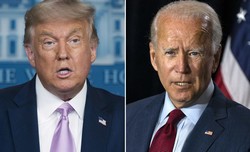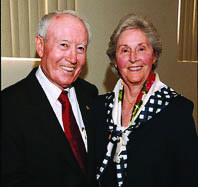Since the University’s newly developed Strategic Plan was accepted and recognized by the Board of Trustees on Oct. 23, the Steering Committee and Provost Laura Moriarty have begun to transition into the implementation process of the plan.
“One of the first items for us is to create an inventory and analysis of the curricular and co-curricular opportunities that currently exist,” said Christine Benol, Steering Committee Co-Chair and Vice President of Enrollment Management.
“Although some items may be implemented in the first year, other initiatives will take several years to complete. Metrics for measuring our achievements will be identified.”
University President Paul Brown said that the guiding principles within the Strategic Plan will determine the University’s course of action over the next five to six years. “Throughout the process, we were very careful not to turn discussions about the overall vision for our future into a checklist of specific initiatives to accomplish. Instead, we focused on a vision for the overarching and unique elements that Monmouth can emphasize as a residential mid-sized university,” Brown said.
According to Benol, the Steering Committee anticipates that the entire Monmouth community will be able to benefit from the plan, and all of the changes that are to come with it.
“As the title suggests, our Commitment to Transformative Learning, the focus of the plan is around the student experience,” said Benol.
Brown added that the name of the plan identifies the specific core elements of the University, in that the educational experience is “transformative for every student, in every area of study.”
Benol said that Monmouth’s core elements particularly played a significant role in the planning and implementation of the Strategic Plan when it came to its effects on the students. “The three Core Elements speak to how the student experience will be impacted as we build on our strong foundation by: one, creating an intellectually challenging and rigorous academic experience with a strong foundation in the liberal arts; two, providing impact and immersive learning experiences that extend beyond the classroom; and three, preparing students for life after Monmouth” Benol said.
Specifically, the plan aims to help both undergraduate and graduate levels. As stated on the University’s main webpage, at the undergraduate level, the plan hopes to give students more access to internships, practicums, and even employment opportunities through increase programs and external partnerships.
For the graduate program, the plan aims to develop more customized, trans-disciplinary graduate programs, like communication, health sciences, public policy, and coastal studies, which will meet the current needs of prospective employers.
Brown said that though the process was lengthy, the main accomplishment and deliberate goal of the planning was to foster several ideas for discussion. “Through our discussions, many different, sometimes passionate, and sometimes conflicting, visions emerged for what the future of Monmouth University should look like. At the end of the process, we identified core areas when that we could really make a difference […] Our vision fits perfectly with our size, our location, and our core strengths,” Brown said.
In order to ensure that the Strategic Plan could accomplish all that it set out to do, a Steering Committee was appointed with Benol and Dr. Kathryn Kloby, an associate professor of political science and sociology, as co-chairs of the committee on December 16, 2013.
The main charge of the Steering Committee was “oversight and the direction of the planning process and preparing the final report,” as Benol said.
Along with the Steering Committee, Benol said there were Theme-Committees created as well, in order to ensure that a balanced plan could be successfully developed.
“The themed committees were charged with helping guide the dialogue with the campus community and identifying benchmarks to support our discussions,” said Benol.
“The four guiding themes were transformative learning experience, program relevancy, global and cultural awareness and a community of teaching, scholarship and collaboration. The chairs of the theme committees were also part of the Steering Committee.”
According to Kloby, it was essential to the committees that all of the students were able to benefit from the plan. “Our goal was to come up with a plan that ensures that all of our students have will have a rich academic experience that is rigorous, impactful, and prepares them for life after Monmouth. That means we take a hard look at how we are successful and where we fall short. We identified so many wonderful courses, activities, travel opportunities, and support services that provide such experiences for our students,” said Kloby.
Kloby mentioned however, that it was difficult finding a platform which allowed for the entire plan to be fully shown. “Our challenge was not having the page space in the strategic plan to celebrate all of our successful initiatives. The task ahead will be to further identify what we do well at Monmouth and how to support [the students] through leadership and resources to advance them,” Kloby said.
While the Strategic Plan has been advertised to the public and the campus community over the past couple of months, there was still some confusion behind what the plan would actually do.
Emily Carper, a sophomore political science major, said that she didn’t have a clear idea of everything the plan aimed to accomplish.
“I don’t know a whole lot about [the Strategic Plan], but I know I would just be able to get bits and pieces from professors who did know about it. I didn’t really hear anything from students about it…because they didn’t really know too much about it either,” Carper said.
According to Brown, the best way for students to get to know more about the strategic plan is to sit down and simply, read it. “The Strategic Plan document that is found on the website goes into more detail, with more examples […] The interactive website is really a distillation of the core elements of the vision, and was designed to encourage everyone to want to learn more,” Brown said.
Also, in order for the plan to be seen as successful and get the word out to the public, Kloby said there needs to also be an investment to inform and assist those in the community.
“We are also mindful that in order for a plan to reach its fullest potential, we need to invest in the people who do the work at Monmouth. We see the strategic plan as an opportunity to rethink our current processes, foster collaboration, and invest in the people who work so hard to teach our students, support our students, and mentor them,” said Kloby.
Ultimately, as the President and all involved in the Strategic Plan would attest, the plan is simply for the betterment of Monmouth’s future, and will continue to do so.
“The strategic planning process was an inclusive and reflective experience. It involved honest discussions of the work that we do for our students and how we can improve so that all students are ensured a transformative learning experience,” said Kolby.
“Our plan gives us our guiding framework. We are committed to seeing this through and making sure that the core elements of the plan come to life for the benefit of our students,” she said.
This article is the second part of a two-part series. The last edition of The Outlook published the first part of the story.
PHOTO COURTESY of Monmouth University




